I traveled to Cincinnati during the week of Labor Day back in September, & visited CAM on Wednesday night. They stay open till 9pm on Wednesdays, & the entire museum was taken over by "One World Wednesday: the food, the drinks, the art, the music of different world cultures." On this particular day (Sep. 6th) Dubai, United Arab Emirates, was in the spotlight (coincidentally the next stop on Quidam's tour). Here are some Fun Facts provided to visitors:
- There aren't any street addresses in Dubai.
- The city of Dubai has a hospital just for falcons.
- The world's only "7 star" hotel is in Dubai.
- Industry experts estimate that 15 to 25 percent of the world's construction cranes are in Dubai.
The many tables of delicious-smelling, delicious-looking food samples & wine-tasting bars crowded & blocked many of the exhibits, but as soon as I walked into the West Asia section, this remarkable treasure immediately caught my eye:
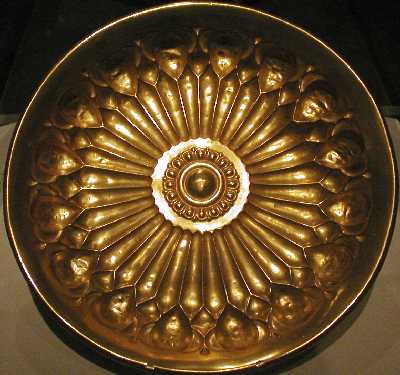
(Note: CAM allows photographs for personal/educational use, unlike one museum I know...)
Here's its placard:
Bowl of Darius the Great
Iran
Achaemenid period, reign of Darius I
(522-486 BC)
gold, hammered, with chased decoration
Museum Purchase
1963.31
As the inscription indicates, this gold vessel was a royal offering to the Persian king Darius I (522-486 BC). The recipient himself is commemorated in a dedication, inscribed beneath the rim, which proclaims "Darius, Great King" in the three official languages of the Achaemenid empire: Persian, Babylonian, and Elamite. To judge from its shape, this vessel was probably used for libation--the ceremonial pouring of wine in honor of a god. It may also have been used as a drinking cup (known in ancient Greek as a phiale). The bowl bears a stylized floral pattern consisting of a central rosette surrounded by the petals of a lotus flower, a design commonly found on drinking cups of the period (see Bowl with frieze of lions hunting bulls, 1957.500). Similar metal vessels are often shown carried by servants or tributaries on the stairway reliefs of the Persian capital at Persepolis (see Relief with attendant Mede, 1955.792). Fashioned from solid gold, this vessel was cast in a stone mold, and its relief decoration was produced by a process of hammering from the interior, known as repousse.
Royal offering? Wine for a god? Rosette pattern? Hmm...
The bowl resides in a clear plexiglas cube so you can walk around it, & the bowl is tilted on a 45-degree angle allowing all sides to be examined. Nice! The photo above shows its interior, though an optical illusion may make it seem like you're looking at the bottom; the 2 photos below were viewed from the bottom showing the inscription:
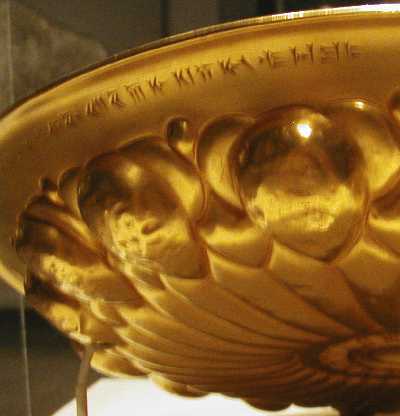
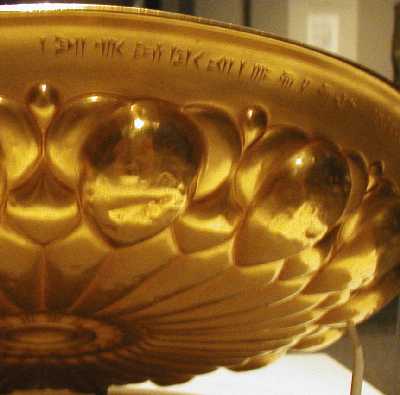
Rosette pattern? Wine for a god? Royal offering? Hmm...
A similar bowl, except for being silver & inscribed to Artaxerxes I, was displayed by the British Museum in their "Forgotten Empire: the World of Ancient Persia" exhibit:
Artaxerxes, the great king, king of kings, king of countries, son of Xerxes the king, of Xerxes son of Darius the king, the Achaemenian, in whose house this silver saucer was made.
Altogether 4 of these silver bowls have been documented, initially by E. Herzfeld ("Eine Silberschussel Artaxerxes I" in AMIran 7, 1935, pp. 1-8, Taf. I-IV), more recently by J.E. Curtis, M.R. Cowell, & C.B.F. Walker ("A Silver Bowl of Artaxerxes I" in Iran 33, 1995, pp. 149-53), & A.C. Gunter & M.C. Root ("Replicating, Inscribing, Giving: Ernst Herzfeld & Artaxerxes' Silver Phiale in the Freer Gallery of Art" in Ars Orientalis 28, 1998, pp. 3-38). (Also see "Inscribed Silver Vessels of the Odrysian Kings: Gifts, Tribute, & the Diffusion of the Forms of 'Achaemenid' Metalware in Thrace" by Antigoni Zournatzi in the American Journal of Archaeology vol. 104 #4, Oct. 2000, pp. 683-706.)
If the gold one I'm documenting here has been published anywhere else, please post a response. All lack provenance, but are believed to be from Hamadan (Ecbatana). Also on display at the British Museum's exhibition was an inscribed gold bowl on loan from the National Museum of Iran.
Next on display at CAM, I saw some solid gold plaques, again inscribed in cuneiform but to a different king:
Foundation plaques
Iran
Achaemenid period, early 4th century BC
hammered gold
Museum Purchase
1963.32, 33
These two inscribed Persian gold plaques served as offerings to commemorate the foundation of one or more royal buildings, according to established ancient Near Eastern custom. Inscribed in Old Persian, the official tongue of the Achaemenid realm, they invoke the protection of the Zoroastrian god Ahuramazda on behalf of the Persian Kings Arsames (ruled 6th century BC) and Artaxerxes II (405-359 BC).
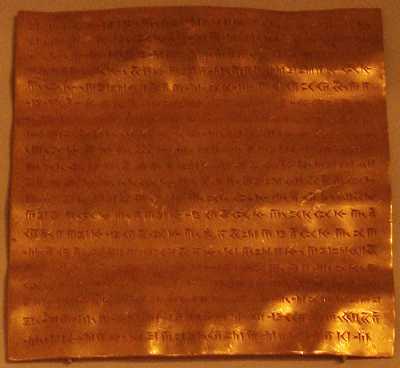
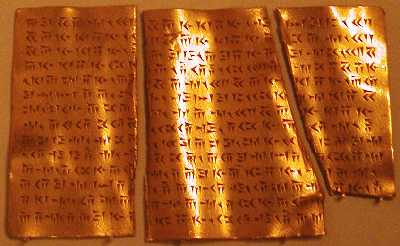
I'm guessing the whole one on top is of Arsames, & the 3 fragments below are of Artaxerxes. If anyone out there can actually read these & confirm this guess, please post a response.
To see the context of similar plaques inscribed with cuneiform, see the foundation deposit from the Apadana of Persepolis & also one of Darius I on the Oriental Institute's website. See also texts AmH, AsH, DPh, DH, A2Hc, XH, & A1I described by Roland G. Kent ("Old Persian", New Haven: American Oriental Society, 1953).
Nor are these Persian specimens the earliest known. According to Percy S.P. Handcock ("Mesopotamian Archaeology: an introduction to the archaeology of Babylonia and Assyria", New York: Putnam, 1912, p. 103):
"Many bronze tablets of the Assyrian period have been found, & the well-known bronze doorstep of Nebuchadnezzar II provides us with another excellent example of an inscription engraved on metal. Moreover the more precious metals such as silver & gold were occasionally inscribed. Inscriptions on gold are very rare, but by no means unknown. M. de Sarzec for example found a plate of gold bearing a cuneiform inscription at Tellô, & a strip of gold bearing the name of the illustrious Naram-Sin of Agade was brought to light in the course of the American excavations at Bismaya."
What struck me the most about these displays at CAM was the complete absence of Biblical references to these 2 kings:
"Then the people of the land weakened the hands of the people of Judah, ... & hired counselors against them to frustrate their purpose, all the days of Cyrus king of Persia, even until the reign of Darius king of Persia. ... Then ceased the work of the house of God which is at Jerusalem. So it ceased unto the 2nd year of the reign of Darius king of Persia."--Ezra 4:4-5,24
"But the eye of their God was upon the elders of the Jews, that they could not cause them to cease, till the matter came to Darius; & then they returned answer by letter concerning this matter. The copy of the letter ... sent unto Darius the king. They sent a letter unto him, wherein was written thus: Unto Darius the king, all peace."--Ezra 5:5-7
"Then Darius the king made a decree, & search was made in the house of the rolls, where the treasures were laid up in Babylon. ... And the God that hath caused his name to dwell there destroy all kings & people, that shall put to their hand to alter & to destroy this house of God which is at Jerusalem. I Darius have made a decree; let it be done with speed. Then Tatnai, governor on this side the river, Shetharboznai, & their companions, according to that which Darius the king had sent, so they did speedily. And the elders of the Jews built, & they prospered through the prophesying of Haggai the prophet & Zechariah the son of Iddo. And they built, & finished it, according to the commandment of the God of Israel, & according to the commandment of Cyrus, & Darius, & Artaxerxes king of Persia. And this house was finished on the third day of the month Adar, which was in the sixth year of the reign of Darius the king."--Ezra 6:1,12-5
"The Levites ... were recorded chief of the fathers: also the priests, to the reign of Darius the Persian."--Nehemiah 12:22
"And Darius the Median took the kingdom, being about 62 years old."--Daniel 5:31
"It pleased Darius to set over the kingdom 120 princes, which should be over the whole kingdom. ... Then these presidents & princes assembled together to the king, & said thus unto him, King Darius, live for ever. ... Wherefore king Darius signed the writing & the decree. ... Then king Darius wrote unto all people, nations, & languages, that dwell in all the Earth. ... So this Daniel prospered in the reign of Darius..."--Daniel 6:1,6,9,25,28
"In the first year of Darius the son of Ahasuerus, of the seed of the Medes, which was made king over the realm of the Chaldeans."--Daniel 9:1
"Also I in the first year of Darius the Mede, even I, stood to confirm & to strengthen him."--Daniel 11:1
"In the 2nd year of Darius the king, in the 6th month, in the 1st day of the month, came the word of the LORD by Haggai the prophet unto Zerubbabel the son of Shealtiel, governor of Judah, & to Joshua the son of Josedech, the high priest, saying, ... In the 24th day of the 6th month, in the 2nd year of Darius the king."--Haggai 1:1,15
"In the 24th day of the 9th month, in the 2nd year of Darius, came the word of the LORD by Haggai the prophet."--Haggai 2:10
"In the 8th month, in the 2nd year of Darius, came the word of the LORD unto Zechariah, the son of Berechiah, the son of Iddo the prophet. ... Upon the 24th day of the 11th month, which is the month Sebat, in the 2nd year of Darius, came the word of the LORD unto Zechariah."--Zechariah 1:1,7
"And it came to pass in the 4th year of king Darius, that the word of the LORD came unto Zechariah."--Zechariah 7:1
"And in the days of Artaxerxes wrote ... unto Artaxerxes king of Persia; & the writing of the letter was written in the Syrian tongue, & interpreted in the Syrian tongue. Rehum the chancellor & Shimshai the scribe wrote a letter against Jerusalem to Artaxerxes the king in this sort. ... This is the copy of the letter that they sent unto him, even unto Artaxerxes the king. ... Now when the copy of king Artaxerxes' letter was read..."--Ezra 4:7-8,11,23
"Now after these things, in the reign of Artaxerxes king of Persia ... there went up some of the children of Israel ... unto Jerusalem, in the 7th year of Artaxerxes the king. ... Now this is the copy of the letter that the king Artaxerxes gave unto Ezra the priest, the scribe, even a scribe of the words of the commandments of the LORD, & of his statutes to Israel. Artaxerxes, king of kings, unto Ezra the priest, a scribe of the law of the God of heaven, perfect peace, & at such a time. ... And I, even I Artaxerxes the king, do make a decree to all the treasurers which are beyond the river, that whatsoever Ezra the priest, the scribe of the law of the God of heaven, shall require of you, it be done speedily, unto 100 talents of silver, & to 100 measures of wheat, & to 100 baths of wine, & to 100 baths of oil, & salt without prescribing how much. Whatsoever is commanded by the God of heaven, let it be diligently done for the house of the God of heaven; for why should there be wrath against the realm of the king & his sons?"--Ezra 7:1,7,11,12,21-3
"These are now the chief of their fathers, & this is the genealogy of them that went up with me from Babylon, in the reign of Artaxerxes the king."--Ezra 8:1
"And it came to pass in the month Nisan, in the 20th year of Artaxerxes the king, that wine was before him; & I took up the wine, & gave it unto the king."--Nehemiah 2:1
"Moreover from the time that I was appointed to be their governor in the land of Judah, from the 20th year even unto the 32nd year of Artaxerxes the king, that is, 12 years, I & my brethren have not eaten the bread of the governor."--Nehemiah 5:14
"But in all this time was not I at Jerusalem; for in the 32nd year of Artaxerxes king of Babylon came I unto the king, & after certain days obtained I leave of the king, & I came to Jerusalem..."--Nehemiah 13:6,7
I expressed the same surprise on ANE-2 this week over the lack of mention of Jews or Jerusalem in association with the exquisite ossuary they have on display, which features not only 2 rosettes, but also 3 triangular objects that may have represented pyramids on the skyline of Jerusalem in ancient times.
Last week I commented on the many contrasts presented by a quasi-historical film. This week we see a similar contrast between Persian history presented in the Bible, & Bible-less history presented at CAM.
Song of the week: "Memories Of Gold" by David Arkenstone, Kostia, & David Lanz (click the song title to visit Amazon; click here for a 26-second sample; 328kb).
G.M. Grena
P.S. [2007-12-8] Thanks to Wilfried Gawantka for providing the following bibliography on this subject:
"The complete data on the three inscribed gold objects in CAM are as follows."
1) The gold plaque cut in three pieces
CAM Museum purchase 1963, 32 or 33: = Kent, AsH.
Editions:
- Ed. pr. 1944 (cf. Kent, 1953, p. 107a, and Schweiger II, 1998, p. 526).
Later editions:
- R. G. Kent, Old Persian, 2nd ed., 1953, s.v. AsH: p. 107a (Lemma); p. 116ab (OP; Engl.).
- Pierre Lecoq, Les inscriptions de la Perse achéménide, Paris 1997, s.v. AsH, p.. 180 (French transl. only.)
- Günter Schweiger, Achämenidische Keilinschriften, Taimering 1998, s.v. AsH: vol. I, p. 150 - 151 (OP; German); vol II, p. 525 - 528 (data, bibliography,transliteration of OP).
- Rüdiger Schmitt, Das spätachaimenidische Altpersische, in: Rüdiger Schmitt, Beiträge zu altpersischen Inschriften, Wiesbaden, 1999, p. 105 - 111: "AmH und AsH", there p. 109 - 111, s.v. AsH (OP; German; linguistic commentary).
- Rüdiger Schmitt, Pseudo-altpersische Inschriften, Wien 2007, p. 27 f., s.v. AsHa (OP; German); Thesis: "nicht-authentische achaimenidenzeitliche Inschrift", that means: the inscription, though said to be found in or nearby Hamadan, the center of modern forgery of Achaimenian objects of interest for private collectors and museums, is not a modern forgery, but genuine in as much as it is from later Achaemenian time; but it is not a document of king Arsames himself or of his time.
Empiric data:
- Schweiger II, 1998, p. 525 (transl. WG): "Gold plaque; OP only, 14 lines. . ca 90 x 130 mm; thickness: unknown; weight: unknown."
- Kent, 1953, p. 107a: "OP only, 14 lines, on a gold tablet in three pieces, complete except for lower right corner; about 9 x 13 cm"; more exactly Schweiger II, p. 525: in the third piece are lost the last two lines, that means the ends of line 13 and 14.
Provenience:
- Schweiger II, S. 525: "Die Tafel gehört zu dem Schatz, der 1920 bei Hamadan gefunden wurde.", that is: "The plaque is part of the treasury found 1920 near Hamadan." - For this no reference! The plaque being in the private collection of "M. Vidal, New York, USA."
--
2) The uncut gold plaque of Artaxerxes II
CAM Museum purchase 1963, 32 or 33, = Kent A2Hc.
Editions:
- Ed. pr.: A. U. Pope, The Illustrated London News, July 17, 1948, p. 58 - 59 (Kent, 1953, p. 114a; ILN non vidi).
Later editions:
- R. G. Kent, 1953, s.v. A2Hc: p. 114a (Lemma); p. 155b (OP; only partial English translation).
- Pierre Lecoq, Les inscriptions de la Perse achéménide, Paris 1997, s.v. A2Hc, p. 270 (French transl. only.)
- G. Schweiger, Achämenidische Keilinschriften, Taimering 1998, s.v. A2Hc: vol. I, p. 162 f. (OP; German); vol. II, p. 555 - 558 (data; bibliography; transliteration of OP).
- R. Schmitt, Das spätachaimenidische Altpersische, in: the same, Beiträge zu altpersischen Inschriften, Wiesbaden, 1999, p. 88 - 91, s.v. A2Hc (OP; German; linguistic commentary).
Empiric data:
- Schweiger II, p. 555: Gold plaque, OP only, 20 lines, complete. Ca. 130 x 130 mm; thickness: unknown; weight: unknown. Provenience and remain (remaining?): Schweiger II, p. 555 (sic!, the same words as p. 525): "Die Tafel gehört zu dem Schatz, der 1920 bei Hamadan gefunden wurde.", that is: "The plaque is part of the treasury found 1920 near Hamadan." - For this no reference! The plaque being in the private collection of "M. Vidal, New York, USA."
Authenticity: Never disputed.
--
3) Gold bowl with inscription of "Dareios", CAM, Museum purchase 1963, 31.
For this bowls cf. now Rüdiger Schmitt, Pseudo-altpersische Inschriften, Wien, (Oct.) 2007, p. 93: The short inscription (OP, Elam, Akk.: "Dareios, Great King") on the 3 (or only 2) bowls he has knowledge of are epigraphically and linguistically correct; but it would be no problem to copy them correctly.
---
Further References:
1) The inscribed gold bowl from the National Museum of Teheran, as loan in the Exibition London, BM:
"Forgotten Kingdom", has an inscription of Xerxes: "Xerxes, Great King" (better in French, which has the same word order as OP: "Xerxès, Roi Grand"), in OP, Elam., and Akk. See the Catalogue of this Exibition, No. 97, and Schweiger, 1998: I, p. 198 - 199 (OP; German); II, S. 563 f.
2) Herzfeld's 4 silver dishes "from Hamadan" with dubious inscription of Artaxerxes II:
See now in extenso with full bibliography:
Rüdiger Schmitt, Pseudo-altpersische Inschriften, Wien 2007, p. 82 - 93, s.v. "F(älschung) 10: Silberschalen ,Artaxerxes' I.'", mit Abb. 16 (color, BM): OP, German translation, comm. Thesis: modern forgery (linguistic and grammatical arguments; convincing).

No comments:
Post a Comment